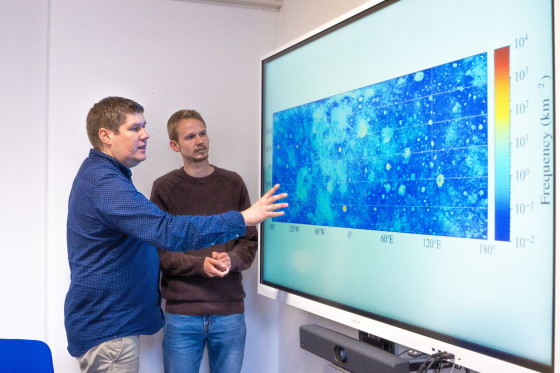
A stone-by-stone survey
From a distance, the moon appears to be motionless and unchanging; a grey, dusty sphere up in the sky, unchanged for billions of years. But this impression is deceptive. Its surface is in constant motion and is formed by countless impacts on it and by the gradual fading of the traces which these cause. Just how dynamic the moon actually is, is shown in a new study produced by researchers at the Institute of Planetology at the University of Münster. For the first time, they have produced a map showing almost 94 million boulders.
“Up to now, what was missing was a consistent, global data basis for researching the moon’s surface in a quantitative way,” explains Ben Aussel, a doctoral student in the Experimental Planetology Working Group led by Prof. Bastian Gundlach. “We wanted to find out how the boulders on the moon are distributed, and what they can tell us about the constitution and the history of its surface.” To this end, Aussel developed a special deep-learning algorithm – i.e. a machine learning process – which automatically recognizes boulders on satellite images. The basis for this was high-resolution images produced by the Narrow Angle Camera on board the NASA satellite Lunar Reconnaissance Orbiter.

The results provide a hitherto unique representation of the size, the location, and the frequency of all the boulders with a diameter of more than four-and-a-half metres. Of the approximately 94 million boulders which were recorded on the moon between 60 degrees north and 60 degrees south, around two-thirds are located in the highlands and one-third in the dark mare regions. The average size of the boulders is around 6.5 metres; some individual boulders are much bigger, though. What can be seen is that the number and the size of the boulders vary greatly, depending on the region and the age of the surface. “There are many boulders around young craters, while older regions appear to be more fine-grained and smoother,” explains Bastian Gundlach. “This helps us to gain a better understanding of the geological history of the moon – in other words, how impacts and weathering in space have changed its surface over millions of years.”
The map not only has scientific value but also has practical uses. It provides valuable indications of dangerous areas for future missions to the moon, or of areas which are particularly suitable – for example, for landings or for the deployment of rovers. “If you know where big boulders are located, you can plan more safely,” says Ben Aussel. Representatives of NASA and the European Space Agency (ESA), which is part-funding the PhD project, have emphasised the importance of the research results at specialist conferences where the junior researcher has presented his findings. The process is not restricted to the moon, says Bastian Gundlach. It can, he says, be transferred to asteroids or other planets – anywhere, in fact, where there are high-resolution images of surfaces.
Ben Aussel is delighted that his work – which began under the supervision of Dr. Ottaviano Rüsch – is attracting a great deal of international attention. “It’s really astonishing what can be done with AI, and what research questions we’ll be able to find answers to in the near future,” he says. His work is already today showing that what was assumed to be a tranquil companion to the Earth is in fact much livelier than it looks. It also makes it clear how research being undertaken in Münster can literally reach the moon.
The results of the study have been published in the “Journal of Geophysical Research: Planets”.
Author: Kathrin Kottke
This article is taken from the university newspaper wissen|leben No. 7, 5 November 2025.
